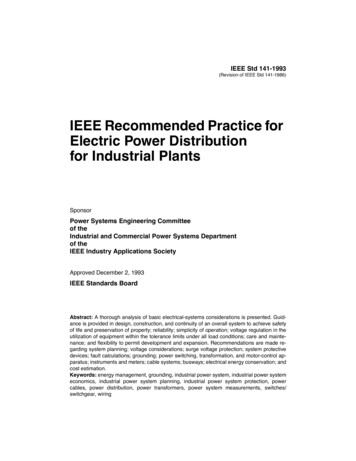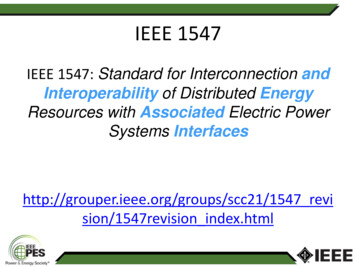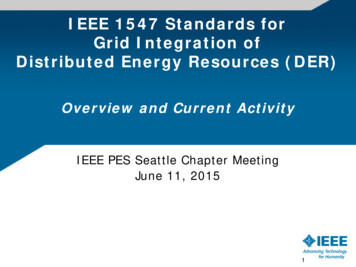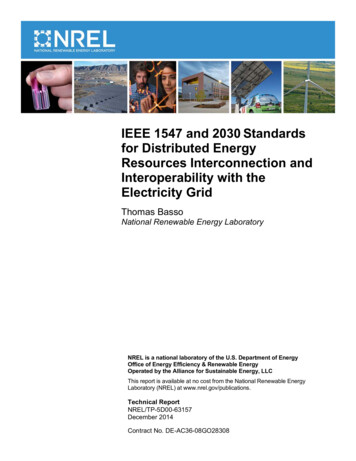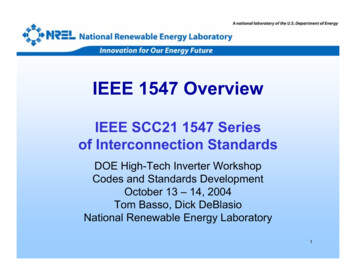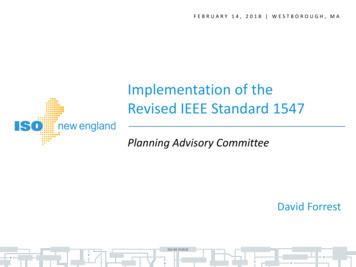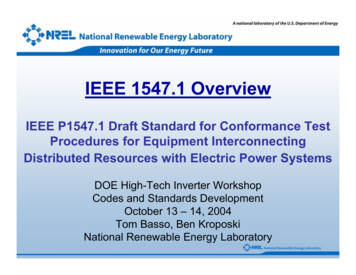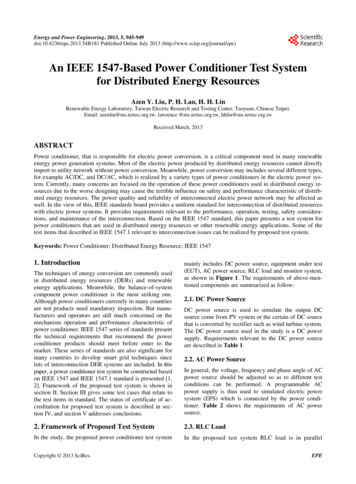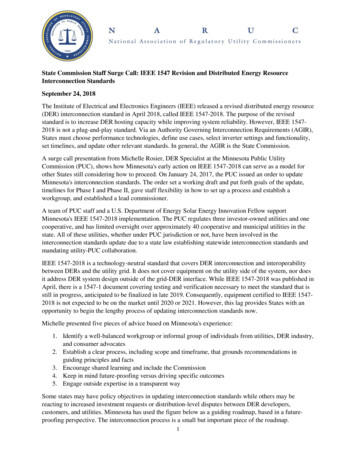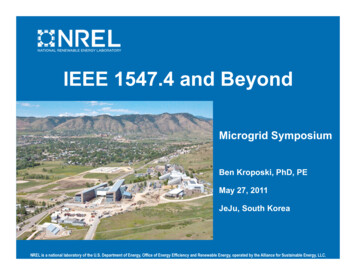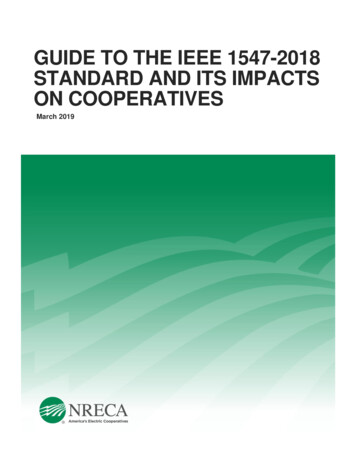
Transcription
GUIDE TO THE IEEE 1547-2018STANDARD AND ITS IMPACTSON COOPERATIVESMarch 2019
GUIDE TO THE IEEE 1547-2018 STANDARD ANDITS IMPACT ON COOPERATIVESThis Guide is owned by the National Rural Electric Cooperative Association (NRECA). For moreinformation, please contact: Robert Harris at robert.harris@nreca.coop or 703-907-5753.This document is not sanctioned by, and does not carry the approval or endorsement of, the IEEE. Theauthor does not represent the IEEE. A copy of IEEE 1547-2018 is available on IEEE’s website 47-2018.htmlScope of this GuideIn order to give cooperative engineers a starting point with the new IEEE 1547-2018 standard, NRECAcommissioned the development of this “field guide.” The intent of this guide is to:1. Provide co-ops with a brief overview of the changes and new features of this standard compared tothe original (both mandatory and optional).2. Provide a guide to establishing settings for 1547-2018 compliant distributed energy resources(DERs) that most closely match those typically used in 1547-2003 compliant DERs (i.e., settingsthat most closely maintain a “business as usual” scenario).3. Identify what settings or features are now mandatory and cannot be disabled.4. Provide an idea of what the impact on a system may be if the new default settings are utilized.This will not be an all-inclusive guide to, nor a replacement for, the standard, but instead it provides ameans for assisting cooperatives in “getting off the ground” with 1547-2018 by relating it to the familiar2003 standard.DisclaimersThe information in this guide is intended to be a helpful and educational resource. This document isNOT intended to replace IEEE 1547-2018. The information is not an exhaustive and completeexamination of issues relating to IEEE 1547-2018. The guide contains information to help cooperativesunderstand the recent changes to IEEE standard 1547 and the potential implications for cooperatives.This document does not establish any requirements and is not a standard itself, and the reader mustobtain a copy of 1547-2018 and rely on its wording and requirements for any interconnection policydecisions.NRECA and the authors are not attempting to render specific legal or other professional advice in thisguide. Electric cooperatives are: (1) independent entities; (2) governed by independent boards ofdirectors; and (3) affected by different member, financial, legal, political, policy, operational, and otherconsiderations. For these reasons, each electric cooperative should make its own business decisions onwhether and how to use this information.
GUIDE TO THE IEEE 1547-2018 STANDARD ANDITS IMPACTS ON COOPERATIVES 1Disclaimer of Warranties & Liability:This guide is provided “as is” and NRECA and the authors make no warranties or representations, eitherexpress or implied, about the information contained in the guide, including warranties of accuracy,completeness or usefulness. This work contains findings that are general in nature. Readers are remindedto perform due diligence in applying these findings to their specific needs, as it is not possible forNRECA or its authors to have sufficient understanding of any specific situation to ensure applicabilityof the findings in all cases. The information in this work is not a recommendation, model, or standardfor all electric cooperatives. Neither the authors nor NRECA assume liability for how readers may use,interpret, or apply the information, analysis, templates, and guidance herein or with respect to the use of,or damages resulting from the use of, any information, apparatus, method, or process contained herein.In addition, the authors and NRECA make no warranty or representation that the use of these contentsdoes not infringe on privately held rights. This work product constitutes the intellectual property ofNRECA and its licensors, and as such, it must be used in accordance with the restriction set forth below.License Right and Confidentiality:This guide is intended solely for use by NRECA voting members and should be treated as confidentialand only shared with others, such as cooperative advisers and consultants, on a “need to know” basis.All Rights Reserved 2019 National Rural Electric Cooperative Association.About the AuthorThis Guide was prepared by Michael Ropp for NRECA:Michael Ropp, Ph.D., P.E.President and Principal Engineer, Northern Plains Power Technologies807 32nd AvenueBrookings, SD 57006-4716Phone: 605-692-8687Email: michael.ropp@northernplainspower.comWeb: www.northernplainspower.com
GUIDE TO THE IEEE 1547-2018 STANDARD ANDITS IMPACTS ON COOPERATIVES 2Table of ContentsSection 1.0 – Introduction . 3Section 2.0 – A Stepping Stone: IEEE 1547A .6Section 3.0 – Major Changes in IEEE 1547-2018 . 7Section 4.0 – Authority Governing Interconnection Agreements(AGIR) . . . 11Section 5.0 – Approximation of IEEE 1547-2003 Voltage andFrequency Relay Settings . . .12Section 6.0 – New Default Settings in IEEE 1547-2018 . . . 15Section 7.0 – Voltage and Frequency Regulation Functions 17Appendix . 19 Summary Comparison of Voltage Setpoints for AbnormalOperating Conditions Summary Comparison of Frequency Setpoints for AbnormalOperating Conditions
GUIDE TO THE IEEE 1547-2018 STANDARD ANDITS IMPACTS ON COOPERATIVES 31.0IntroductionWhen IEEE 1547-2003 standard was written, distributed energy resources (DERs) were still relativelyrare and sparsely deployed. They represented only a tiny fraction of the power generation capacity of thesystem then, so the effects of DERs were almost entirely local. As a result, the 2003 standard’sphilosophy centered largely around ensuring that DERs did not interfere with the normal operation ofthe distribution system’s regulation and protection systems. By extension, this also meant that bothworker and public safety were the top priority.The 26-page 2003 standard had four main groups of requirements: General Requirements, Response toAbnormal System Conditions, Power Quality, and Islanding. Some of the requirements imposed by the2003 standard were the following:1. Scope1. The 2003 standard applied to DERs with an aggregate rating of 10 MVA or less, connectedto distribution systems.2. Definitions2 Specifically:a. Electric Power System was abbreviated “EPS.” The 2003 standard defines a Local EPS as anEPS contained entirely within a premise or group of premises, such as an industrial plant orcommercial facility. An Area EPS is one that directly serves Local EPSs, generally understoodto mean the distribution system. (The term “distribution” was avoided because that term haddiffering definitions for different system operators.) The 2003 standard did not specificallydefine any system above the Area EPS.122003 standard Clause 1, and particularly 1.3.2003 standard Clause 3.1.
GUIDE TO THE IEEE 1547-2018 STANDARD ANDITS IMPACTS ON COOPERATIVES 4b. Cease to energize. The 2003 standard defined cease to energize as a cessation of energy outflowcapability. It was silent on whether this implied open contacts or other electrical isolation, anddid not specifically mention VAR flows.c. Trip. The 2003 standard contains no definition for “trip,” although the term is used in thestandard in conjunction with under-frequency settings.3. Voltage Regulation3 DER was prohibited from regulating the voltage at their Point of CommonCoupling (PCC). Traditionally, this has not been interpreted as disallowing fixed power factorcontrol, because that mode is not voltage regulation per se.4. Response to Area EPS faults4 The 2003 standard required that a DER cease to energize the AreaEPS if there is a fault on the circuit to which it is connected. The 2003 version did not specificallyaddress open-phase conditions.5. Cease-to-Energize Pickup Thresholds and Clearing Times for Abnormal Voltages5 None of thethresholds or clearing times were adjustable (see the following table).Voltage range (per unit of “base voltage”6) Clearing time (s)7 1.20.161.1-1.210.88-1.1No requirement0.5-0.882 0.50.166. Pickups and Clearing Times for Abnormal Frequencies8 For small systems ( 30 kW) bothover- and under-frequency trip settings were very tight. For systems 30 kW, there were two underfrequency trips allowed: one fixed at 57 Hz and tripping in 0.16 s, and the other adjustable over theranges shown in the following table.32003 standard, Clause 4.1.1.2003 standard, Clause 4.2.1.52003 standard, Table 1.6The 2003 standard defined the “base voltages” according to the values listed in Table 1 of ANSI C84.1-1995.7From Table 1 of IEEE 1547-2003. For DER rated at less than 30 kVA, the clearing times were to be interpretedas maximum clearing times. For larger systems, the clearing times given were default clearing times.82003 standard, Table 2.4
GUIDE TO THE IEEE 1547-2018 STANDARD ANDITS IMPACTS ON COOPERATIVESDER rating (kW) Frequency range (Hz) 30 30 5Clearing time(s) 60.50.16 59.30.16 60.50.16 {57 – 59.8}{0.16 – 300} 57.00.16In practice, the adjustable under-frequency trip was typically set to 0.16 s clearing time as well.The corresponding threshold was typically set to either 57 Hz (identical to the fixed underfrequency trip) or 59.3 Hz (identical to the settings for smaller systems). Higher underfrequency trips than 59.3 Hz were sometimes used for rotating DER. The 2003 standard alsorequired that under-frequency trip9 setpoints be coordinated with Area EPS operations.7. Power Quality The 2003 standard provided basic power quality requirements by setting limits forDC current injection, harmonic current injection, and voltage flicker caused by the DER.8.Islanding The 2003 standard covered only the prevention of unintentional islanding, and requiredthat any island cease to be energized in either 2 s10 or prior to the first reclose attempt by the AreaEPS protection if it is shorter than 2 s11.9. Communications (called “monitoring”)12 Any DER unit larger than 250 kVA, or any aggregationof DER rated at more than 250 kVA at the PCC, was required to provide monitoring of the real andreactive power output of the DER, the voltage at the PCC, and the DER’s connection status. Thestandard did not specify formats or protocols, nor to whom this information was to be provided.As noted earlier, this is the only place in the main-body text of the 2003 standard in which the term “trip” is used.2003 standard, Clause 4.4.112003 standard, Clause 4.2.2.122003 standard, Clause 4.1.6.910
GUIDE TO THE IEEE 1547-2018 STANDARD ANDITS IMPACTS ON COOPERATIVES 62.0A Stepping Stone: IEEE 1547AThe IEEE Standards Association and Standards Coordinating Committee 2113 recognized in the early2010s that a revision was needed to IEEE 1547-2003, but the DER deployment environment waschanging much more quickly than the standards process could accommodate. Thus, as a stopgapmeasure, Amendment 1 to IEEE 1547-2003 was approved in May of 2014. The 1547A amendmentallowed changes to the requirements in three sections of 1547-2003:1. It removed the absolute prohibition on voltage regulation at the POI, and replaced it with anallowance for voltage regulation by a DER, if mutually approved by the DER and Area EPSoperators.2. It modified language in the section on Voltage and replaced the original table on over/under-voltagesettings.3. It also modified language in the section on Frequency and replaced the original table on over/underfrequency settings.13IEEE SCC21 is the Standards Coordinating Committee on Fuel Cells, Photovoltaics, Dispersed Generation, andEnergy Storage. It oversees the process of development of the IEEE 1547 family of standards, among others, andhelps maintain coordination among standards development processes.
GUIDE TO THE IEEE 1547-2018 STANDARD ANDITS IMPACTS ON COOPERATIVES 73.0Major changes in IEEE 1547-2018The 138-page IEEE 1547-2018 was developed in a very different DER deployment environment. Manyare now seeing sufficient levels of DER deployed that the impacts on their systems are significant. As aresult, the philosophy of the new standard is different as well: there is a pronounced shift towardensuring Bulk Power System (BPS) dynamic and transient stability. Safety is still important, but it isnow weighed against these other factors. Specifically, looking at the items described above from the2003 standard:1. Scope The 2018 standard still applies to DER connected to distribution, but the 10 MVA aggregatesize limit has been removed.2. Definitions Specifically:a. Authority Governing Interconnect Requirements (AGIR): The 2018 standard defines theAGIR as the agency that has authority for setting the requirements for interconnection to theArea EPS.b. The definitions for EPS, Area EPS and Local EPS are all essentially unchanged in the 2018standard, but there is a new definition of the Bulk EPS, or BPS (Bulk Power System) which isessentially taken to be the transmission system and all generation connected to it.c. Cease to Energize: In the 2018 standard, the definition of “cease to energize” has been clarifiedwith a note that “cease to energize” does not imply or require open contacts or other “air-gap”electrical isolation. This means that “cease to energize” can be achieved by any means that stopsreal power outflow from the DER, such as gate blocking in the case of an inverter, withoutopening any external breakers. Limitations have also been added with respect to reactive powerflows that can take place while still meeting the definition of “cease to energize.”
GUIDE TO THE IEEE 1547-2018 STANDARD ANDITS IMPACTS ON COOPERATIVES 8d. Trip: The 2018 standard does define “trip,” but the definition may be different than somereaders would intuitively expect because “trip” also does not necessarily imply any form of opencontacts or other “air-gap” electrical isolation.In the 2003 standard, after ceasing to energize, a DER was required to delay its return t
When IEEE 1547-2003 standard was written, distributed energy resources (DERs) were still relatively rare and sparsely deployed. They represented only a tiny fraction of the power generation capacity of the system then, so the effects of DERs were almost entirely local. As a result, the 2003 standard’s philosophy centered largely around ensuring that DERs did not interfere with the normal .


